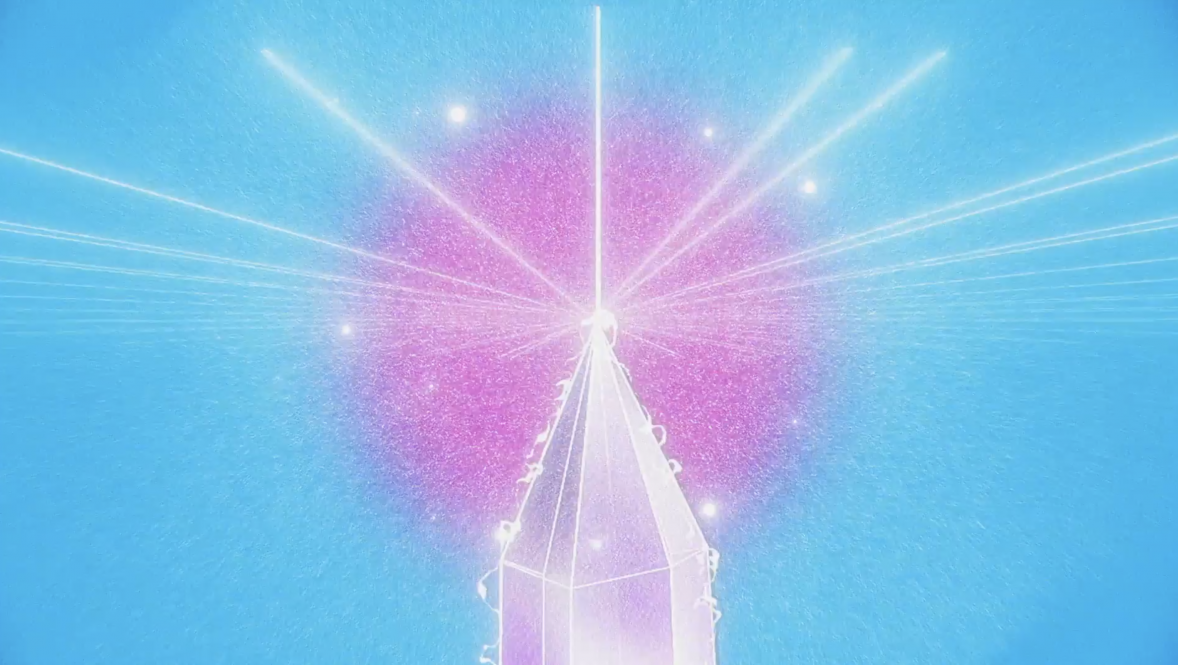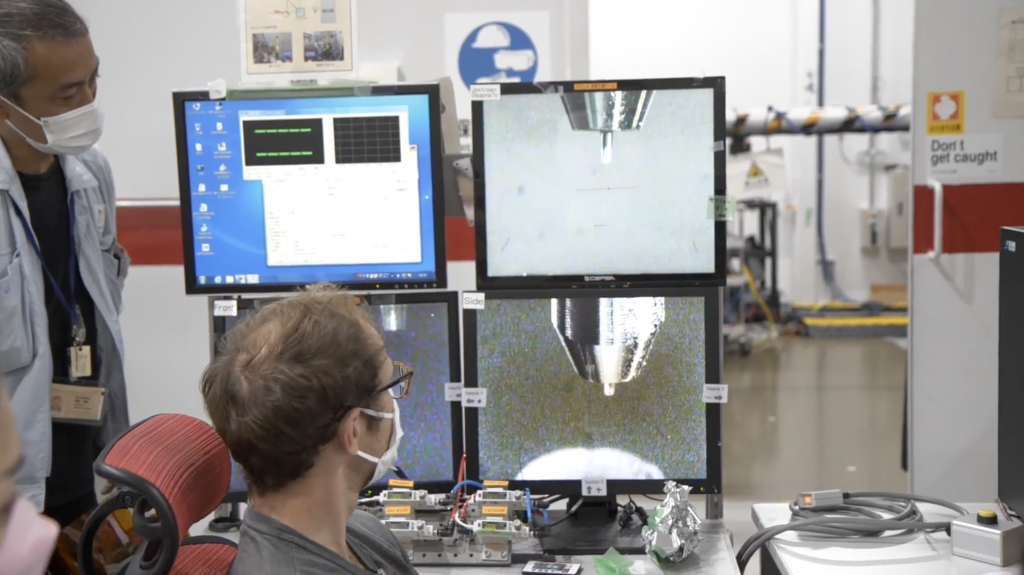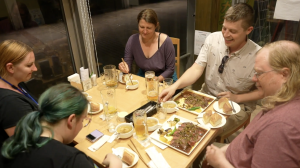A professor's laser-powered journey to solving new quantum materials

In this still from the documentary "BEAMTIME: Crystal Hitters," an artist depicts a crystal being struck by lasers and diffracting light.
In 2022, a multi-institutional team of American scientists traveled to Tokyo to take a spin on a high-powered X-ray laser.
Led by UConn chemistry assistant professor J. Nathan "Nate" Hohman, they hoped to use the machine's unique capabilities to study new materials whose molecular structure had never been understood before. The team had been awarded 60 hours of highly coveted "beam time" on the SPring-8 Angstrom Compact free-electron LAser X-FEL laser (referred to as SACLA).
"They were going to let us squirt through the nozzle anything we wanted," Hohman says, "as long as we told them the name of the chemical first."
The research team included five scientists working in chemical synthesis, X-ray crystallography, and AI-powered data interpretation - all prepared for the scientific equivalent of an ultramarathon. Once the machine powered on, they needed to work continuously until the 60 hours had elapsed.
"If we ran out of stuff to shoot, we were going to be wasting those precious photons," Hohman explains. So, the team brought as many samples of new materials as they could.

Working in round-the-clock shifts, they carefully prepared their samples and loaded them into the machine. SACLA shot jets of their crystalline molecular samples into a chamber where they were struck by an intense beam of X-ray light.
Like prisms throwing rainbows, these crystal samples diffracted the light, each into its own signature pattern. By analyzing the light pattern, the scientists could determine the precise molecular makeup of the crystals they were studying.
By the end of their three-day journey with SACLA, the researchers had solved the structures of four materials - and have gone on to solve more than 50 in eight more experiments around the world over the last two years.
This scientific breakthrough is chronicled in the new short documentary "BEAMTIME: Crystal Hitters," co-directed by Jonathan Turton and Phil MacDonald.
Small Scale, Huge Payoff
High-profile projects like this are nothing new to Hohman, whose research has been sponsored by the US Department of Energy for its potential to unlock new, better sources of energy.
Hohman doesn't work on the quantum technology side of things - using new materials to assemble devices like quantum computers and lasers - but the semiconductors he studies are integral to this process.
"Every new technology has a new material at its core," he says.
Hohman's specialty is self-assembly. His work revolves around understanding the geometry of molecules, planning how they crystallize, and using that to influence their properties. The materials he's interested in tend to form crystals at the microscopic level, thousands of times smaller than grains of sand.
Understanding the structure of these crystals - what's known as "solving" the crystal structure - is the key to understanding how these materials can be used in technological applications spanning energy production, quantum computing, and beyond.
A famous example of crystallography is Rosalind Franklin's discovery of the double-helix structure of DNA. Since no microscope was powerful enough to allow her to literally see the double-helix, Franklin relied on X-ray crystallography to mathematically solve the structure.
For this project, Hohman deployed a unique approach called small-molecule serial femtosecond crystallography, or smSFX.
"Our collaboration led the first-ever use of serial crystallography to fully solve true unknown crystal structures of small-molecule systems," Hohman says. "This solved a huge problem in our field - before, if you were making materials that formed small crystals, then you couldn't easily solve the crystal structure."
Before using this technique, Hohman jokes, "life with my tiny crystals was mostly just despair."
The materials he was interested in studying - known as MOChas, or metal-organic chacogenolates - would form crystals that were simply too small to solve using conventional methods. They possessed interesting properties, like luminescence, that seemed potentially useful in applications like solar cells or LEDs; but without understanding their molecular structure, scientists couldn't figure out how to harness these properties.
"You can control all the photonic, electronic, and quantum properties of systems synthetically in the laboratory by editing a molecule or changing the design of that molecule," Hohman says. "But if you don't know what the structure of something is, then all you have is a little pile of stuff that sort of glows when you shine a UV light on it."
The team's "big breakthrough" was using smSFX to solve the structures of very small molecules. They are hopeful that this will pave the way for developing new materials for green energy and climate change mitigation technologies. Some of the materials they solved show potential for applications like solar power and carbon sequestration.
More broadly, the smSFX technique could be used in future trials to analyze all manner of new materials, from quantum semiconductors to cancer treatments.
Hohman is now turning his focus to publishing the library of materials solved on this trip.
"The materials are really quite cutting-edge; it's hard to say exactly what they will be used for," Hohman says. "The scientific community, collectively, is just starting to discover this stuff." But he notes that the materials his group has solved may offer "a lot of material advantages" for quantum information science.
The Tokyo Shift

Hohman was joined on the 2022 trip to SACLA by colleagues from various institutions, including Aaron Brewster, Daniel Paley, and David Mittan-Moreau of the Lawrence Berkeley National Laboratory; Elyse Schriber, a then-graduate student researcher in Hohman's lab who is now a project scientist at the SLAC National Accelerator Laboratory; and Vanessa Oklejas, who has moved to a new role at Lockheed Martin.
Three current members of Hohman's lab were also on the team: Maggie Willson, Patience Kotei, and Masha Aleksich, now third- and fourth-year doctoral students.
For Willson, who received her bachelor's degree at the University of Central Oklahoma, it was her first time traveling out of the country.
"That whole trip was very surreal for me," she says. "I had graduated the May before that trip, so I hadn't even started grad school yet."
As Hohman tells it, one of the first things he asked Willson to do after accepting her into his lab was "hop on a plane to Japan." Thankfully, she rose to the occasion - and gained experience that proved pivotal in her career path.
"After this trip, I have done seven more of these experiments (in CA, the UK, and another in Japan) and have dedicated the majority of my work here in grad school to these types of crystallography experiments," Willson says. "Before graduate school, I was planning on becoming a professor at a primarily undergraduate institution in order to focus on teaching, but I am now working towards a career at a synchrotron or an X-ray free electron laser in order to do these types of experiments for other research groups."
For Kotei, who received her bachelor's and master's degrees at the Kwame Nkruma University of Science and Technology in Ghana, the trip was similarly propulsive.
"My graduate research primarily focuses on serial crystallography, and my visit to SACLA broadened my perspective on ultrafast dynamics and advanced structural characterization techniques," says Kotei. "Experiencing world-class research infrastructure firsthand reinforced my motivation to pursue high-impact research. Currently, I am in discussions with leading scientists and experts at SACLA regarding potential research opportunities after completing my degree."
Aleksich, a fourth-year chemistry PhD candidate specifically focusing on MOChas, credits the trip to Tokyo with shifting her goals and her understanding of herself as a scientist.
"Having the opportunity to conduct research at this level as a second-year graduate student really grew my confidence and took off any limitations I have had about the caliber of research I would be able to work on in my lifetime," she says. "Growing up, of course I looked up to the greats like Marie Curie and Rosalind Franklin, but I figured that I was not qualified to truly advance the scientific field. But this experience showed me that if an idea is there, and it's able to be well communicated, then people are interested in funding it. And for every one great scientist we remember, there were hundreds who helped along the way."
"BEAMTIME: Crystal Hitters" is available to stream on YouTube.






